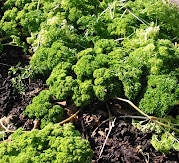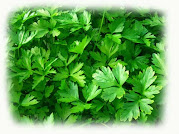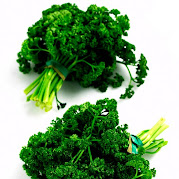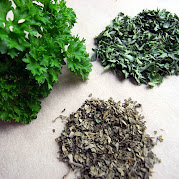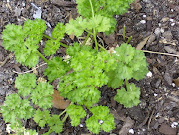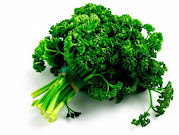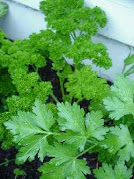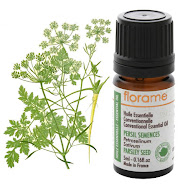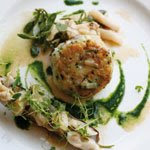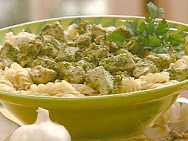Parsley
Petroselinum crispum (curled parsley)
Petroselinum neapolitanum (Italian parsley)
Petroselinum sativum (Hamburg parsley)
Fam: Apiaceae formerly Umbelliferae
In recent years parsley has gotten a bad reputation. It's considered the underwhelming herb — even being shunned as too pedestrian or old-fashioned for modern palates. There is little doubt the herb's reputation has suffered after the many years when sprig of parsley was the only herb used as a garnish, a single sprig at the side of the plate or chopped and sprinkled over smashed potatoes.
Spice Description
There are three common varieties of this popular, bright green biennial: flat leaf (Italian), curly leaf, and parsnip rooted (Hamburg).
The curly type, Petroselinum crispum, is aptly named for the clean, fresh, crispy taste of the tightly bunched, bright green leaves. This crispiness is one of parsley's best attributes, adding texture and colour when added just before serving. This is the parsley that is the essential ingredient in the classic flavoring: bouquet garni, along with thyme and bay leaves. Together with tarragon, chives and chervil, parsley helps make up the traditional French flavoring blend of fine herbs. Chopped and added at the last moment, it perks up sauces and salads.
The second common variety of parsley, flat leafed or Italian parsley (Petroselinum neapolitanum) has a more delicate sawtoothed leaf pattern which does not hold up as well for garnishing.
There is a third and much less familiar form of parsley called Hamburg parsley or Soup parsley (var. sativum). In this variety the root that is the star of the show. The leaves can be used but they are a bit too strong for most people's taste. Its flavor is a pungent cross between celery and parsley -- definitely tasty. It can be sliced raw and added to salads, or cooked and added to soups, stews, gratins, or vegetable purees.
Origin and History
Parsley has been cultivated and developed over so many centuries that its precise origins are difficult to pinpoint, compounded by the probability that all the parsieys we know nowadays, bear little resemblance to their ancestors. The botanical name Petroselinum comes from the Greek word for stone, which is petro, given to parsley because it was found growing on rocky hillsides in Greece. Although the Ancient Greeks did not use parsley in cooking, it was revered as a symbol of oblivion and death and as a funeral herb. According to legend, parsley sprang up where the blood of the Greek hero Archemorus was spilled when he was eaten by serpents. The Greeks used the herb to fashion wreaths for graves. The Romans are said to have used it at orgies to cover up the smell of alcohol on the breath, while also aiding digestion. And there's the unflattering remark that was once made about those who looked as if at death's door: "The man's in need of parsley" (Corpses were sprinkled with parsley to deodorize them.)
Parsley is mentioned often throughout history, and not only for its culinary and medicinal properties. The early Greeks made crowns of parsley to bestow upon the winners of the Nemena and Isthmian sports games, in the same manner that bay wreaths honored the Olympians. Parsley is used in the Hebrew celebration of Passover as a symbol of spring and rebirth. It is mentioned as one of the plants in the gardens of Charlemagne and Catherine de Medici. Rumor has it that Medici is responsible for popularizing parsley when she brought it back to France from its native Italy. In medieval times parsley was surrounded by much superstition, one belief being that the long germination period for the seeds was due to them having to travel to hell and back seven times before sprouting. Superstitious farmers would refuse to transplant parsley and some were even too afraid to grow it at all.
Preparation and Storage
Fresh parsley, often the curly variety, is the most readily available of all fresh herbs. Buy bunches that are not wilted, with springy, erect, almost bristly leaves. Rinse thoroughly in cold water to remove any grit that may have become trapped in the curly leaves and squeeze dry. To store, either put the bunch of parsley in a glass of water then keep it in the refrigerator, or wrap the fresh sprays in foil and freeze them.
Dried parsley is best purchased in small amounts and regularly, as it loses its color and flavour rapidly when sitting on a supermarket shelf. Look for deep-green 'flakes' that are free from pieces of stalk and yellow leaves. Always store away from any source of direct light and keep in airtight packaging away from extreme heat and humidity.
There is very little that does not benefit from the addition of parsley -- it's good in stews, sauces, cheese spreads, rice dishes, vegetables, omelettes, and in fish dishes. It helps add color to pestos. Deep-fried, it makes an intriguing garnish. The ancient Romans combined parsley with cheese and bread for meals.
Culinary Uses
The fresh flavour and crisp mouth-teel ot parsley makes it an ideal accompaniment to most foods. It is traditionally featured in well-known herb blends like fines herbes (with chervil, chives and tarragon) and in bouquet garni with thyme, marjoram and bay leaves.
Fresh or dried parsley may be used in omelets, scrambled eggs, mashed potatoes, soups, pasta and vegetable dishes and in sauces to go with fish, poultry, veal and pork. It is included with garlic and butter for making garlic bread or simply garnishing a juicy, sizzling barbecued steak. Parsley is a key ingredient, along with mint in the healthy and nutritious Middle Eastern salad, tabouleh.
Flat-Ieaved parsley is found in Moroccan dishes, from spiced tagines with preserved lemons, to dishes flavored by a chermoula blend that includes coriander leaves, onions, cumin and cayenne pepper. With its stronger flavour, it is more frequently used in cooking, particularly since it stands up well to heat. For instance, try using the stems rather than the leaves when you want the freshness of parsley in a white sauce but don't want the color to bleed. Persillade and gremolada are two well known sauces which have parsley as one of the main ingredients. Persillade, a French sauce, is a sauteed mixture of finely chopped parsley and garlic. It is added just before serving to broiled meats, particularly lamb and beef, as well as chicken or vegetables. Gremolada is a Milanese condiment made of sauteed parsley, garlic, lemon and orange zest. This mixture is traditionally spread over osso bucco just before serving, although it enhances any braised meats.
Attributed Medicinal Properties
Parsley Root has been used medicinally since ancient times for digestive disorders, bronchitis, and urinary tract problems. As far back as Hippocrates parsley was used in medicinal recipes for cure-alls, general tonics, poison antidotes, anti-rheumetics and formulas to relieve kidney and bladder stones. One herbalist used the small brown seeds of the plant to help "those who are light-headed to resist drink better."
The volatile oil increases circulation to the digestive tract. In Russia, a preparation containing mostly Parsley juice is given during labor to stimulate uterine contractions. The juice has been used to treat toothache, and as a hair rinse or as a facial steam for dry skin. Other uses for Parsley Root have been to tone the urinary tract reducing the possibility of infections, alleviate painful menstruation, lowering blood pressure and improving asthma, allergies and bronchitis by drying excessive mucous.
Modern science has confirmed many of these claims. Parsley is rich in vitamins and minerals, particularly vitamins A and C, and compounds that clear toxins from the body. It also reduces inflammations, contains histamine inhibitors and is a free radical scavenger. Commercially, oil from the seeds is used to scent Oriental style perfumes and colognes. Because of the high clorofil content, it acts as a great breath freshener. Scientists have even isolated a compound, apiol, which is now used in medications to treat kidney ailments and kidney stones.
Plant Description and Cultivation
Both Italian and curly varieties are biennials, but are usually treated as annuals, planted anew each spring. The process to start a parsley plant from seed is a very slow one: the seeds must first be soaked overnight then given warm conditions. Even then they may not sprout for several weeks. This long gestation has given rise to a saying that "parsley seeds must go to the devil and back nine times before sprouting." Once they do sprout they prefer part to full sun, and regular water. Six plants, set 8 inches apart, will supply the average family and allow enough for freezing or drying. If you let a few plants go to seed late in the season, they may produce seedlings for the next year's crop. You can lift the plants in late September, cut them back, and grow parsley on a window ledge through the winter. Protected window boxes seeded in early autumn will produce a late-autumn crop. They will grow 6-12" and do well in pots. The tufted leaves are ready to harvest the first year, and most gardening books recommend planting anew from starts each year. When they flower in the second year, they produce tiny, cream colored blossoms.
